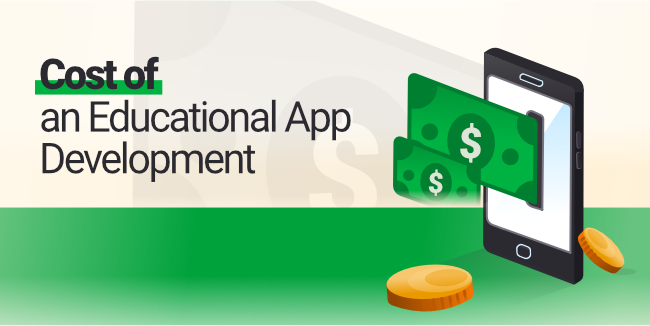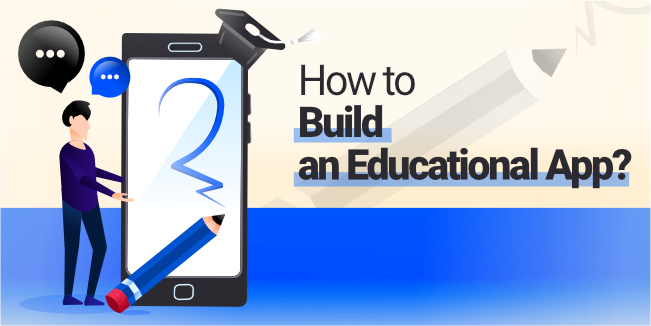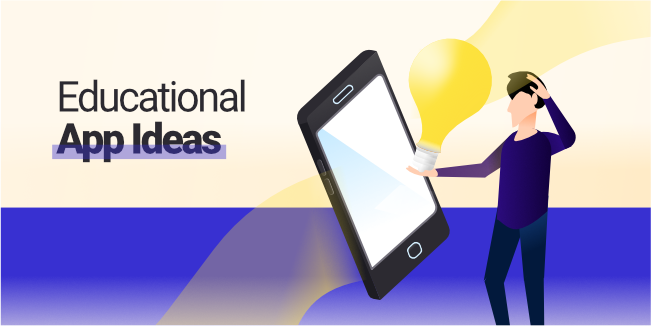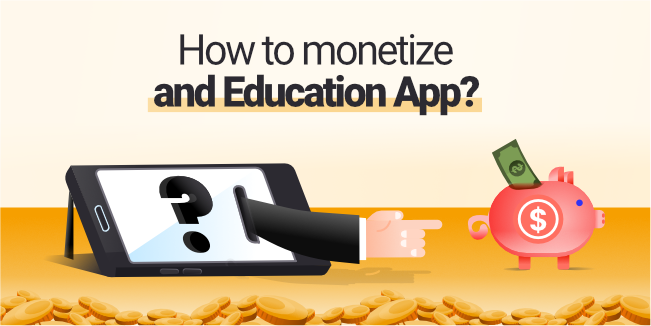development
mobileapp
education
Complete Guide on How to Make an Educational App

Education has always been a crucial aspect of the life of every person. It's not about degrees proving that you finished; it's about real knowledge and professional skills. For this reason, mobile applications from the EdTech industry have become extremely popular for several years.
Creating an application is a big challenge that requires knowledge, experience, and time. In addition, in the case of educational applications, even more than in the case of other types of applications, user knowledge, in-depth market research, and appropriate UX/UI design are essential, which must result from the above issues. Therefore, before you start working on a mobile application on your own (which is associated with a huge amount of work and time), consider working with a software development partner who will smoothly guide you through this process.
What are Educational Apps?
Educational applications are now being used in schools and colleges to help instructors. You may learn many things on the go using your smartphone or tablet, including how to drive or code, study engineering, or catch up on your school curriculum. Simply said, mobile educational apps assist people in learning.
There are several parameters by which one can categorize educational apps. For example, by the target audience. You can make an application for both the student and the teacher.
There will be differences in terms of features between educational and teaching applications. And certain apps can be classified into both of these categories.
Types of Educational Apps
As mentioned before, education app development is increasingly becoming the pathway ahead for significant technology service providers and the module of choice for the eLearning audience. However, the development of these apps depends on the audience they will invite or target.
Based on most user types of educational applications, they may be divided into learning solutions for kids, instructors, and anybody who takes up self-study through online courses. So let's dive into the types of education apps.
Apps For Students
One of the most lucrative stages for a business is to create educational or learning applications for students. It's a difficulty in and of itself, catering to a user base that is the litmus test for technological progress. Students are, by definition, different in terms of their age and subject area knowledge.
The educational app developers should provide an app that is flexible and particular while at the same time being varied to capture the maximum advantages with the broadest user base feasible. We've gone through some of the most typical learning apps schools create these days.
Apps For Learning in School
Most educational applications, especially those developed for students to help with their schoolwork, assist the school curriculum. Apps such as google classroom allow students and teachers to interact using a common medium to teach subjects according to the standard school timetable. Users may exchange videos, pictures, and written material during ongoing video classes.
The school can use the app to let students and teachers upload, access, and moderate instructional materials, tasks, and schedules. In a virtual classroom, an atmosphere is created when both parties may exchange information in real-time.
The development of new software applications during the global epidemic in 2020 contributed to the education sector. Mobile learning became so popular and widespread that schools, colleges, and students could thrive in their positions.
Exam Preparation Apps
While educational eLearning applications provide users access to learning materials according to their convenience and location, they may also be created for specific purposes that enhance the overall learning experience.
Developing unique applications that support a variety of test formats, such as multiple-choice and subjective, allows tutors to post different question paper types for various disciplines to prepare students for examination situations.
Users of all ages, high school students, entrance exam candidates, and advanced students download these apps to learn what kinds of questions they may expect in their examinations. The learning app gives instant feedback on their attempt allowing them to track their learning process more efficiently.
Language Learning Apps
Learning a new language through an educational mobile app is no longer unusual. Because the world is becoming increasingly global, people seek to learn a new language to explore possibilities in their geographic region of interest.
eLearning applications developed for language learning purposes provide a platform for language experts or tutors from various parts of the world to sign-up for tutoring lessons, one-on-one or group sessions, and share their language proficiencies.
Learners may look for and compare tutor profiles to find someone who fits their requirements, goals, and expectations for the language course.
eLearning Apps
Extra courses are no longer restricted to a college curriculum. Students want to improve their knowledge spectrum for a specific subject or field through online education by taking additional classes. These apps were created with distinct databases for various course materials in mind.
Customers may access the course materials they have purchased and customize their accounts based on their preferences. Meticulously created courses that teach a topic in various interesting ways boost students' understanding of the subject and interest in learning more.
Gamified Apps
Gamified basics are used to build smart or unique approaches to learning various subjects. They allow students to engage in multiple activities to learn a specific topic. Gamified applications' popularity is greatest among school-going children because they help promote the learning process.
After a while, reading the same thing over and over might become boring. The gamified applications are designed to break away from the monotony by getting students to contribute to creating, developing, constructing, and applying what they've studied. We have created an article, "What is gamification? Guide (2022)," from which you will learn about this topic.
"Learn by Fun" Apps
Despite the debate over restricting screen time for children, the COVID epidemic necessitated the usage of contemporary eLearning techniques. It's this opportunity that the young people have seized and used to their advantage to make kids feel channelized in the most effective ways possible.
Learning applications that make learning entertaining and engaging for young children have altered the notion of teaching concepts to kids. Today's parents are searching for programs that help their children acquire new information in an innovative method, ones they can identify with as they grow up.
Benefits of Educational App Development
When it comes to the advantages of eLearning app development, there are a lot of them. However, certain advantages apply only to one group. It's critical to understand not just the benefits for business and academic learning but also their distinctions.
We can include benefits for businesses:
- It's easy to keep track of employees' progress,
- Provides easy access to answers,
- Increase productivity and efficiency by automating common processes.
And for students:
- Connect experts to learners on different sides of a chasm,
- Allow for a variety of learning styles to meet all sorts of needs.
We invite you to consider the following advantages of eLearning app development as a possible explanation for why this technology is set to become the most widely accepted type of online learning.
Costs of an Educational App Development

The cost of developing an educational app depends on the price of creating an MVP. The price varies on several variables, including the intricacy of an idea and the complexity of an app development firm's facilities. Let's look at a few more details.
The Complexity
The complexity of the application's idea has an immediate and significant impact on development expenses.
The complexity of a product is defined by the degree of difficulty in business logic, such as the number of roles, functions, features, integrations, etc.
"Complex" implies more sophisticated design, research, and preparation.
Finally, complicated business applications generally need more infrastructure development. Adding additional security measures, for example, or implementing autoscaling via Kubernetes are just a few possibilities.
Type of Development Team
Your mobile app development team has a significant impact on the expense of an educational application. Therefore, it is essential to get some software outsourcing and education industry know-how.
You'll be spending far more money if you give the contract to US-based educational app developers than if you provide the same deal to a team in Poland.
Type of an Application
When estimating the cost of making an educational app, keep in mind what you're creating.
Developing an instructional program for a single platform might be less expensive than developing it for many platforms.
Similarly, the cost of mobile apps will increase significantly if you're developing for wearables (such as augmented reality) or connected TVs.
What Platform?
Another detail to consider is the operating system. Native apps are created specifically for one type of OS.
Hybrid apps combine features of iOS and Android applications. Hybrid programs are also more cost-effective since you only pay once for double work.
Costs That Nobody Talks About
The hidden expenses of app development include upkeep and promotion. You can't establish an e-learning firm that individuals will like without both of these.
Maintaining your app includes upgrading its features and functionalities, fixing essential bugs, scaling servers, etc.
How to Build an Educational App?

When you want to create an educational app development services, you must prepare your actions first. Have this knowledge by being familiar with the business and technical phases of the solution's development.
Business Development Stage
The discovery stage is the first stage of the development process. What exactly is it?
It's a stage for executing the founder's concept in market conditions. It'll allow you to test business ideas and pick the most viable ones.
The project development team analyzes and gathers information needed to create an EdTech app during the discovery stage. The group then assesses whether a project is usable, feasible, and viable based on what it learns.
You can learn more from the article "What is the Product Discovery and Product Discovery Process?". In it, we cover almost everything about the discovery process that is the critical element of our Discovery Workshops.
Customer Research
Customer research is critical for determining customers' requirements, actions, and segments. It may be part of your EdTech design study or as market research.
Startups should seek to find out potential users of their EdTech platform and those who already use other goods you develop and are likely to use your platform.
The sort of application you intend to develop determines the scope and extent of your consumer research. As a result, it's critical to understand how your app works to provide your consumers with a fantastic user experience.
Competitor Research
Competitor analysis entails looking for firms with the same product and assessing both the product and company's shortcomings and advantages.
The most significant threat to your firm's success is the competition, so it's crucial to look at the most significant rival. It's critical to compare the biggest competitor to see how they match up. Competitor research can also help you identify industry trends you may overlook.
Create Your Scope and Specifications
The scope and specifications of a contract are parts of the business development process, which entails establishing and documenting a list of deliverables, responsibilities, deadlines, activities, and costs.
It's the summary of what needs to be done and when it must be completed, all in one document.
UX/UI Design
The UI/UX design of the platform has a significant impact on user experience and client satisfaction. A strong app design should assist you in gaining your target market's trust and pushing them to use your product time and again.
Set The Milestones and Deadline
As a startup that works with the quickest time to market, you must establish a tight delivery timetable with the EdTech app development team.
However, this deadline should not be so tight that it risks the software development process. Agreeing on tangible goals is a fantastic method to do this. Milestones are also useful in monitoring the progress of your project's performance.
For example, we can see the following feature's workflow, which starts after signing in. Let's assume that you're looking at the learning resource catalog or choosing a mentor.
The discovery process guides a development team, ensuring that you fully comprehend one another and have the same objectives.
Technical Development Stage
The technical development phase is simple because you, as a young company, don't have to do much. This crucial and delicate stage's performance relies on the assigned app development firm.
The development team is in charge of developing the app as planned and customizing it to match your target demographic's needs. Creating an MVP and a scaled MVP are parts of the technical build process.
Building an MVP
The MVP is a startup development strategy that focuses on the fundamental capabilities of an educational app. The goal of an MVP is to quickly and cheaply test the riskiest product idea on the real market. With a flexible strategy, you may quickly change a startup to discover that model that works and leads to enormous growth.
This issue is discussed in more detail in a separate article, "Build your MVP (Minimum Viable Product) the right way - step by step guide by mDevelopers."
A minimum viable product might include features that aren't vital to the application but will increase user engagement. Of course, if the project's budget permits, you should think about this option. Here are some of these features:
- Resources Catalog - It aids in navigating online courses for visitors to your education platform.
- Search and Categorization - Users can distinguish valuable information from useless data.
- Video Feedback - It is crucial if you want to provide your users with the greatest possible user experience.
- Learning Statistics - This will give you some basic statistics regarding your pupils' learning patterns.
Software Development Team Structure
Software development team structure is one of the most critical aspects that will affect the success and cost of the project. The application's needs determine the structure of the software development team. They will require a team of seven individuals, according to our experience:
- Project Manager,
- Business Analyst,
- UX/UI designer,
- CTO,
- Backend developer,
- Mobile developer,
- QA tester.
It's also worth noting that the tech stack impacts the team's makeup. You'll need a different developer for each platform if you're coding in native apps.
Creating Tech Stack
The tech stack is a grouping of technologies used in the development process. The stack is dependent on the application's goals and objectives.
You usually need to choose the right one for your project regarding technologies. And these technologies are to be responsible for:
- Backend,
- Frontend,
- 3rd party integrations,
- Server.
It's also worth noting that the technology stack will differ depending on your chosen team.
Educational App Ideas

The priority is to determine the type of app to be developed. For example, is the app primarily for students/learners, tutors/teachers, or corporate experts? Make sure the user stories are well-written and that the flow of the application can assist in achieving the educational app's ultimate objective.
As we know very well, how many people, so many ways of learning. It is worth considering what target group we want to reach. Okay, we know we want to reach the students, but how we do it is just as important.
For this reason, we have compiled a list of some proven, but sometimes not noticeable, ideas for your educational app.
Private Tuition App
Students have always valued private coaching because it is the surest method to achieve outstanding grades. Private tuition learning app allows students to connect with experts swiftly and simply.
Students can ask a teacher about any concerns they may have. After a discussion, students may get notes from specialists through the private tuition application.
Language Learning App
This app is self-explanatory and is used for learning different languages. The app is suited for both students and teachers. Today's students are moving from one nation to another for further education; therefore, they must master the language they have relocated to.
Teachers may also benefit from this learning app and can directly educate children to earn extra money.
Question and Answer App
Students and teachers find locating and building their questions and answers challenging. With that in mind, this program was created to make it simple for students to discover their inquiries and prepare for the response.
This program allows you to ask and answer questions, including test series that aid pupils in their self-assessment. You may also build a module for this app that contains additional questions and answers to assist students.
The biggest difficulty in creating this application is creating a sufficiently large database.
Dictionary App
The only one of these that isn't an age issue is a dictionary app, which is beneficial to both pupils and instructors. Before the decade, people used to carry a pocket dictionary. However, the scenario has changed dramatically since then. You may now have a dictionary program on your phone.
People are more likely to use the apps than lug around thousands of pages in a dictionary. It also benefits the user, who may find it quicker to look up words and meanings. You may also have an app development firm build you a customized directory application.
Audio Book App
The audio concept isn't new in the market. For example, many of us saw the idea of learning CDs for language learning. The application can adjust the level to the student in an exciting way, which is why it is much more versatile than a regular CD. While using an app, users don't need to download or read the book. Students may start the Audiobook for any book through this app, which functions similarly to YouTube.
It's sometimes difficult to read the books because they contain uncommon words, so it's better to utilize the audiobook app. When you're on vacation or driving, you may use it.
How to Monetize an Educational App?

As you know, developing an application is a lot of work, time, and money. So it's not surprising that you want to get back somehow your invested funds or just get paid for your job. Smart and non-invasive monetization of the application is an excellent way to get rewards for the effort. Here are some simple ways to earn money from an educational app:
Freemium
You provide a restricted version of your software and urge customers to acquire the complete edition if they enjoy it. Even the free edition, however, should be completely functional.
The free version has the same lessons as the paid one, but you'll get access to additional features if you pay for a subscription.
Free Trial
You may offer a free trial to your users to access all app capabilities for a specified time before asking them to pay if they wish to continue. It's a fair deal because you show the user everything he can pay for afterward. Two weeks is usually sufficient time to get used to an app but not enough time to become bored.
Ads
Ads as a monetization approach should be used with caution in an educational app. Interrupting a lesson with an ad is ineffective and considered a significant shortcoming. Your software development firm may provide market research-based strategy suggestions if you opt for advertising.
Conclusion
Virtual education and eLearning have emerged as popular applications that require an app interface since the world has now reached a new level of acceptance for technology-mediated procedures in all areas.
With each educational group and would-be entrepreneur vying to join the ranks of adopting mobile learning with their curriculum or eLearning module, a custom mobile app appears to be the ideal solution.
Developing a compelling and easy-to-use education app that gives the learning experience advantage over traditional methods is an art. This short manual will serve as a checklist to ensure you don't overlook any crucial features while developing an eLearning software. We hope you do great. Good luck!